wheel CHRYSLER CROSSFIRE 2008 1.G Service Manual
[x] Cancel search | Manufacturer: CHRYSLER, Model Year: 2008, Model line: CROSSFIRE, Model: CHRYSLER CROSSFIRE 2008 1.GPages: 358, PDF Size: 4.7 MB
Page 248 of 358
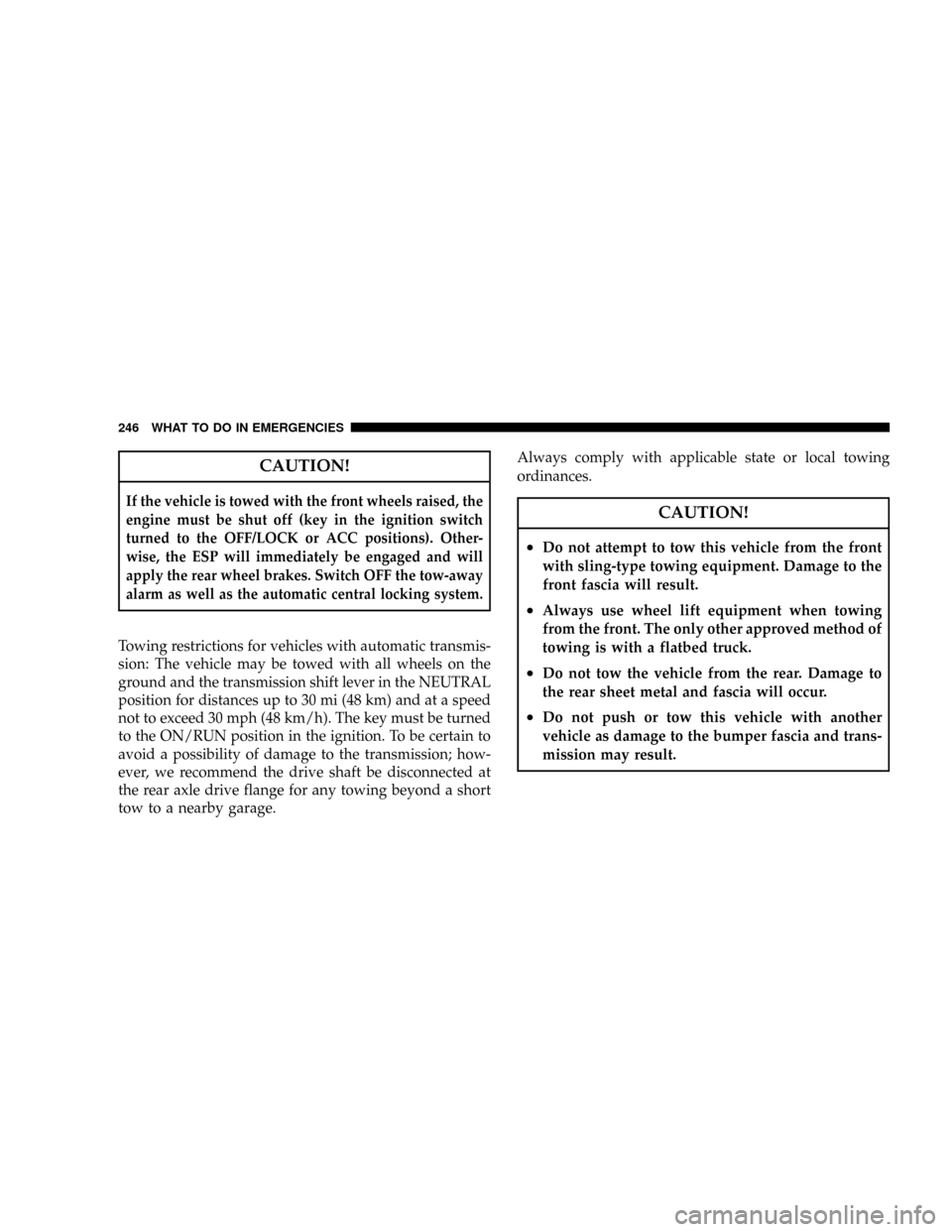
CAUTION!
If the vehicle is towed with the front wheels raised, the
engine must be shut off (key in the ignition switch
turned to the OFF/LOCK or ACC positions). Other-
wise, the ESP will immediately be engaged and will
apply the rear wheel brakes. Switch OFF the tow-away
alarm as well as the automatic central locking system.
Towing restrictions for vehicles with automatic transmis-
sion: The vehicle may be towed with all wheels on the
ground and the transmission shift lever in the NEUTRAL
position for distances up to 30 mi (48 km) and at a speed
not to exceed 30 mph (48 km/h). The key must be turned
to the ON/RUN position in the ignition. To be certain to
avoid a possibility of damage to the transmission; how-
ever, we recommend the drive shaft be disconnected at
the rear axle drive flange for any towing beyond a short
tow to a nearby garage.Always comply with applicable state or local towing
ordinances.
CAUTION!
²Do not attempt to tow this vehicle from the front
with sling-type towing equipment. Damage to the
front fascia will result.
²Always use wheel lift equipment when towing
from the front. The only other approved method of
towing is with a flatbed truck.
²Do not tow the vehicle from the rear. Damage to
the rear sheet metal and fascia will occur.
²Do not push or tow this vehicle with another
vehicle as damage to the bumper fascia and trans-
mission may result.
246 WHAT TO DO IN EMERGENCIES
Page 249 of 358
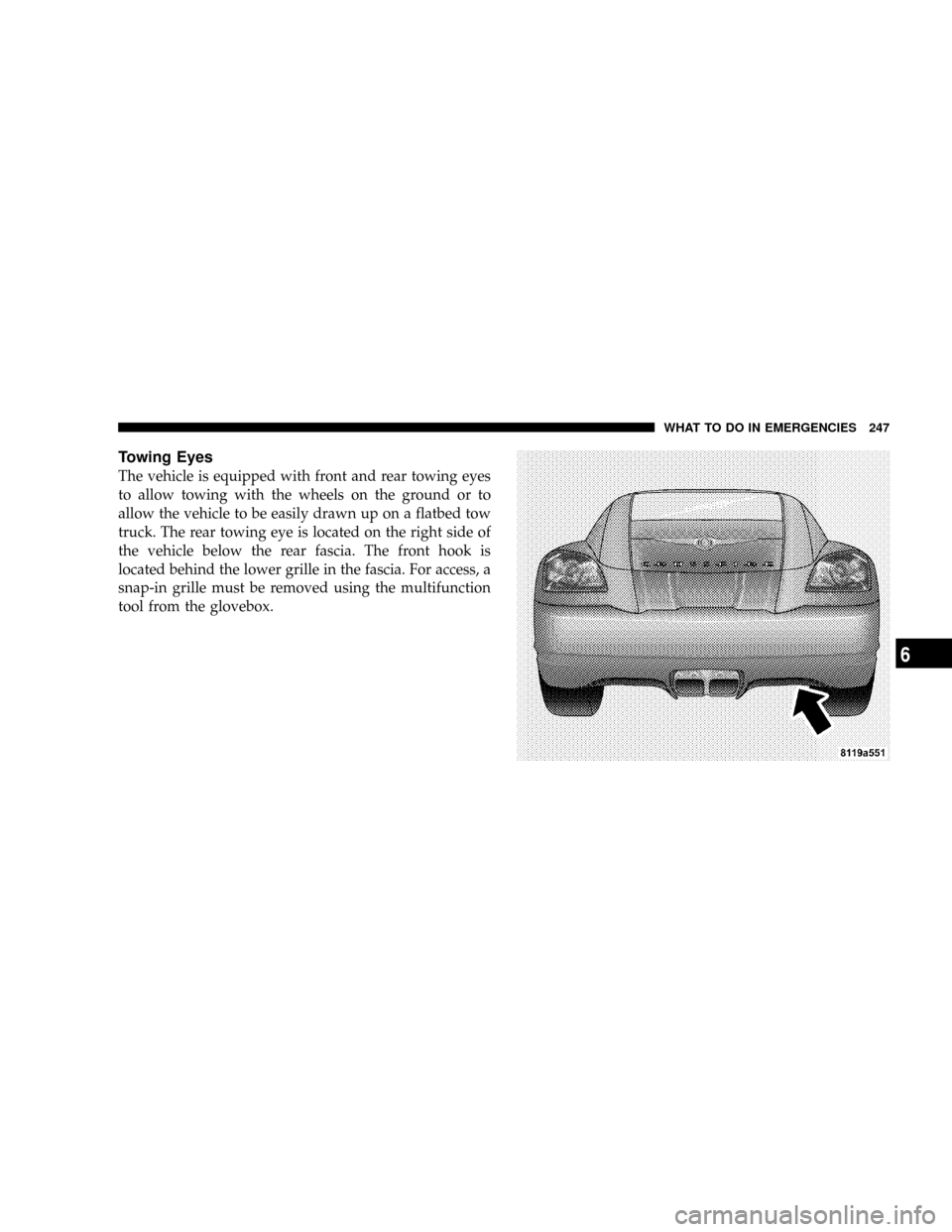
Towing Eyes
The vehicle is equipped with front and rear towing eyes
to allow towing with the wheels on the ground or to
allow the vehicle to be easily drawn up on a flatbed tow
truck. The rear towing eye is located on the right side of
the vehicle below the rear fascia. The front hook is
located behind the lower grille in the fascia. For access, a
snap-in grille must be removed using the multifunction
tool from the glovebox.
WHAT TO DO IN EMERGENCIES 247
6
Page 294 of 358
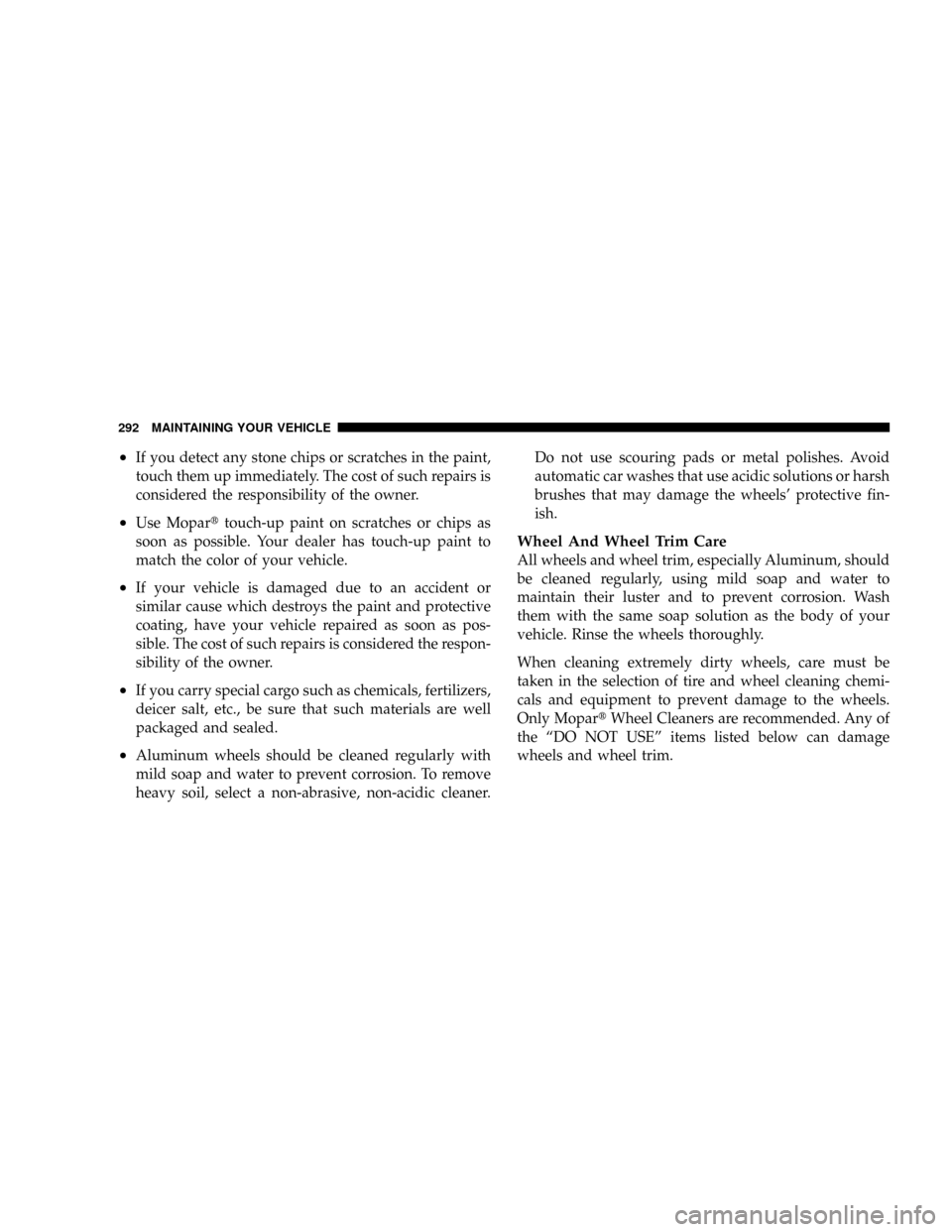
²If you detect any stone chips or scratches in the paint,
touch them up immediately. The cost of such repairs is
considered the responsibility of the owner.
²Use Moparttouch-up paint on scratches or chips as
soon as possible. Your dealer has touch-up paint to
match the color of your vehicle.
²If your vehicle is damaged due to an accident or
similar cause which destroys the paint and protective
coating, have your vehicle repaired as soon as pos-
sible. The cost of such repairs is considered the respon-
sibility of the owner.
²If you carry special cargo such as chemicals, fertilizers,
deicer salt, etc., be sure that such materials are well
packaged and sealed.
²Aluminum wheels should be cleaned regularly with
mild soap and water to prevent corrosion. To remove
heavy soil, select a non-abrasive, non-acidic cleaner.Do not use scouring pads or metal polishes. Avoid
automatic car washes that use acidic solutions or harsh
brushes that may damage the wheels' protective fin-
ish.
Wheel And Wheel Trim Care
All wheels and wheel trim, especially Aluminum, should
be cleaned regularly, using mild soap and water to
maintain their luster and to prevent corrosion. Wash
them with the same soap solution as the body of your
vehicle. Rinse the wheels thoroughly.
When cleaning extremely dirty wheels, care must be
taken in the selection of tire and wheel cleaning chemi-
cals and equipment to prevent damage to the wheels.
Only MopartWheel Cleaners are recommended. Any of
the ªDO NOT USEº items listed below can damage
wheels and wheel trim.
292 MAINTAINING YOUR VEHICLE
Page 295 of 358
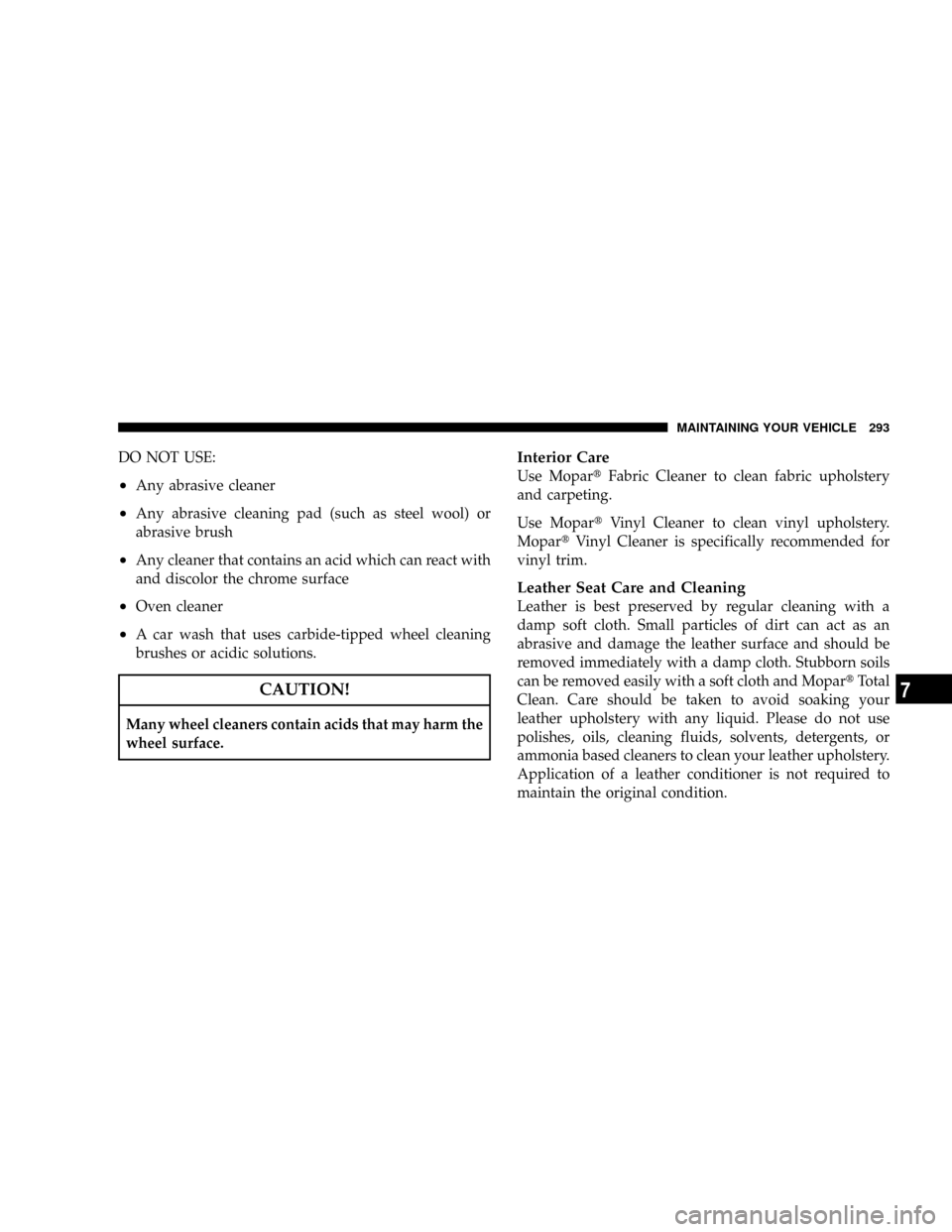
DO NOT USE:
²Any abrasive cleaner
²Any abrasive cleaning pad (such as steel wool) or
abrasive brush
²Any cleaner that contains an acid which can react with
and discolor the chrome surface
²Oven cleaner
²A car wash that uses carbide-tipped wheel cleaning
brushes or acidic solutions.
CAUTION!
Many wheel cleaners contain acids that may harm the
wheel surface.
Interior Care
Use MopartFabric Cleaner to clean fabric upholstery
and carpeting.
Use MopartVinyl Cleaner to clean vinyl upholstery.
MopartVinyl Cleaner is specifically recommended for
vinyl trim.
Leather Seat Care and Cleaning
Leather is best preserved by regular cleaning with a
damp soft cloth. Small particles of dirt can act as an
abrasive and damage the leather surface and should be
removed immediately with a damp cloth. Stubborn soils
can be removed easily with a soft cloth and MopartTotal
Clean. Care should be taken to avoid soaking your
leather upholstery with any liquid. Please do not use
polishes, oils, cleaning fluids, solvents, detergents, or
ammonia based cleaners to clean your leather upholstery.
Application of a leather conditioner is not required to
maintain the original condition.
MAINTAINING YOUR VEHICLE 293
7
Page 314 of 358
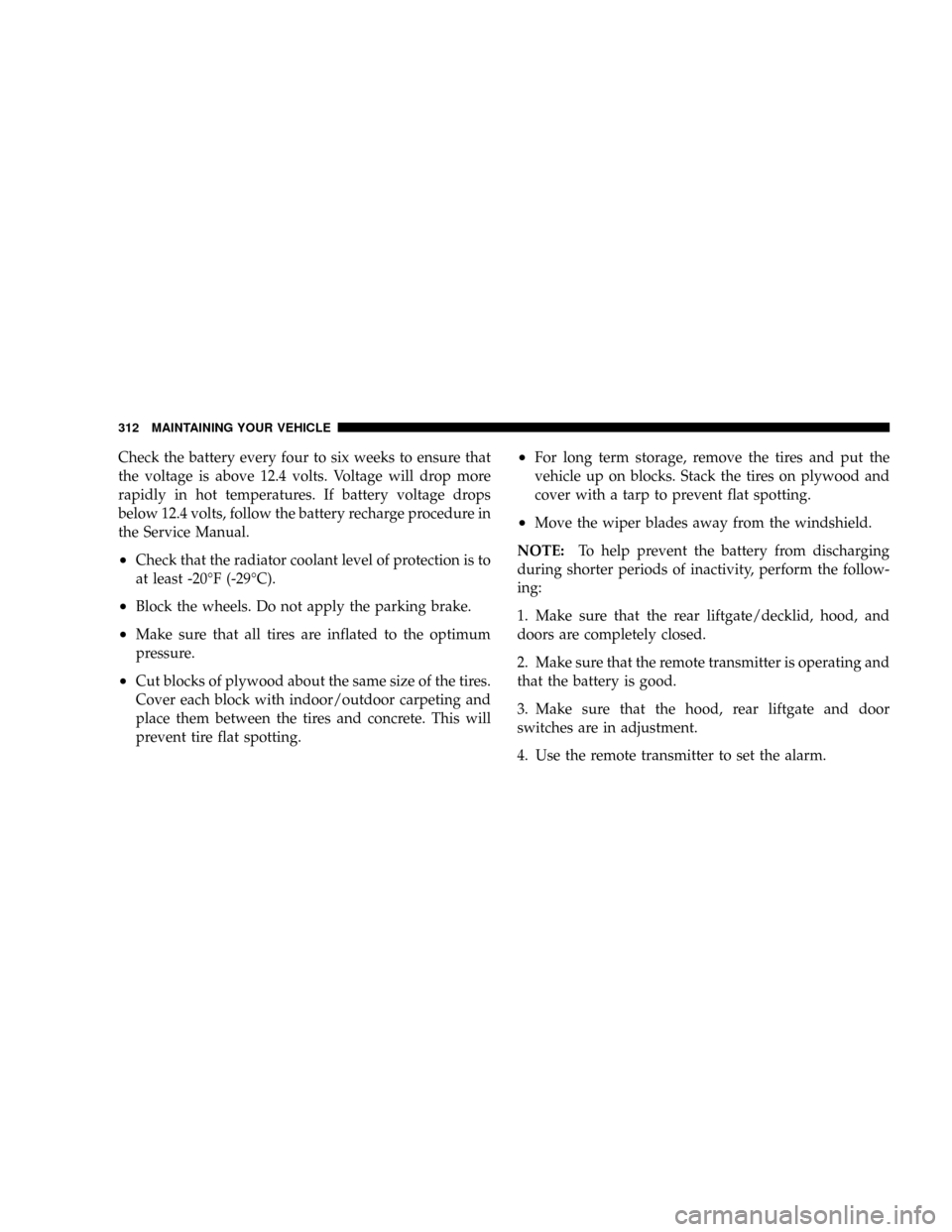
Check the battery every four to six weeks to ensure that
the voltage is above 12.4 volts. Voltage will drop more
rapidly in hot temperatures. If battery voltage drops
below 12.4 volts, follow the battery recharge procedure in
the Service Manual.
²Check that the radiator coolant level of protection is to
at least -20ÉF (-29ÉC).
²Block the wheels. Do not apply the parking brake.
²Make sure that all tires are inflated to the optimum
pressure.
²Cut blocks of plywood about the same size of the tires.
Cover each block with indoor/outdoor carpeting and
place them between the tires and concrete. This will
prevent tire flat spotting.
²For long term storage, remove the tires and put the
vehicle up on blocks. Stack the tires on plywood and
cover with a tarp to prevent flat spotting.
²Move the wiper blades away from the windshield.
NOTE:To help prevent the battery from discharging
during shorter periods of inactivity, perform the follow-
ing:
1. Make sure that the rear liftgate/decklid, hood, and
doors are completely closed.
2. Make sure that the remote transmitter is operating and
that the battery is good.
3. Make sure that the hood, rear liftgate and door
switches are in adjustment.
4. Use the remote transmitter to set the alarm.
312 MAINTAINING YOUR VEHICLE
Page 316 of 358
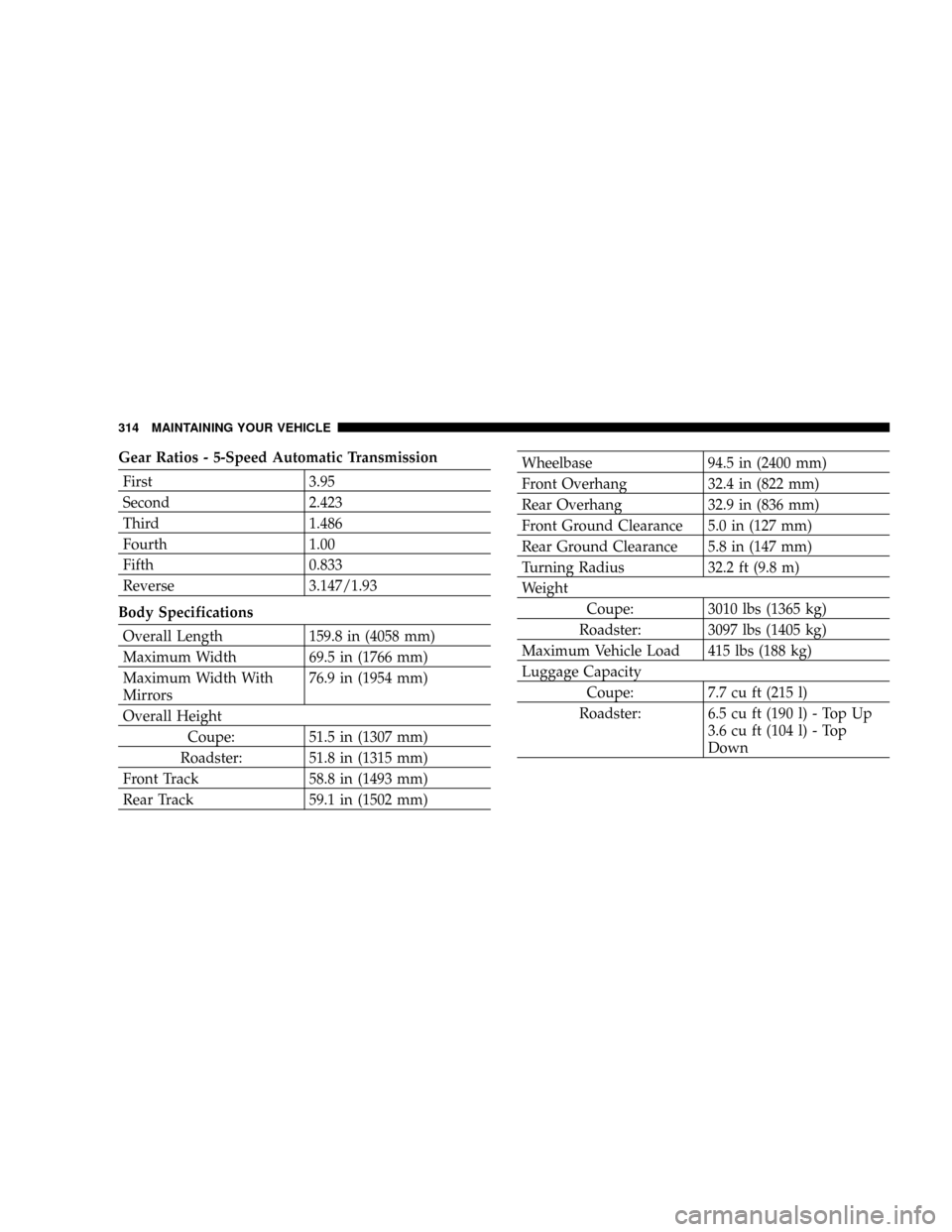
Gear Ratios - 5-Speed Automatic Transmission
First 3.95
Second 2.423
Third 1.486
Fourth 1.00
Fifth 0.833
Reverse 3.147/1.93
Body Specifications
Overall Length 159.8 in (4058 mm)
Maximum Width 69.5 in (1766 mm)
Maximum Width With
Mirrors76.9 in (1954 mm)
Overall Height
Coupe: 51.5 in (1307 mm)
Roadster: 51.8 in (1315 mm)
Front Track 58.8 in (1493 mm)
Rear Track 59.1 in (1502 mm)
Wheelbase 94.5 in (2400 mm)
Front Overhang 32.4 in (822 mm)
Rear Overhang 32.9 in (836 mm)
Front Ground Clearance 5.0 in (127 mm)
Rear Ground Clearance 5.8 in (147 mm)
Turning Radius 32.2 ft (9.8 m)
Weight
Coupe: 3010 lbs (1365 kg)
Roadster: 3097 lbs (1405 kg)
Maximum Vehicle Load 415 lbs (188 kg)
Luggage Capacity
Coupe: 7.7 cu ft (215 l)
Roadster: 6.5 cu ft (190 l) - Top Up
3.6 cu ft (104 l) - Top
Down
314 MAINTAINING YOUR VEHICLE
Page 342 of 358
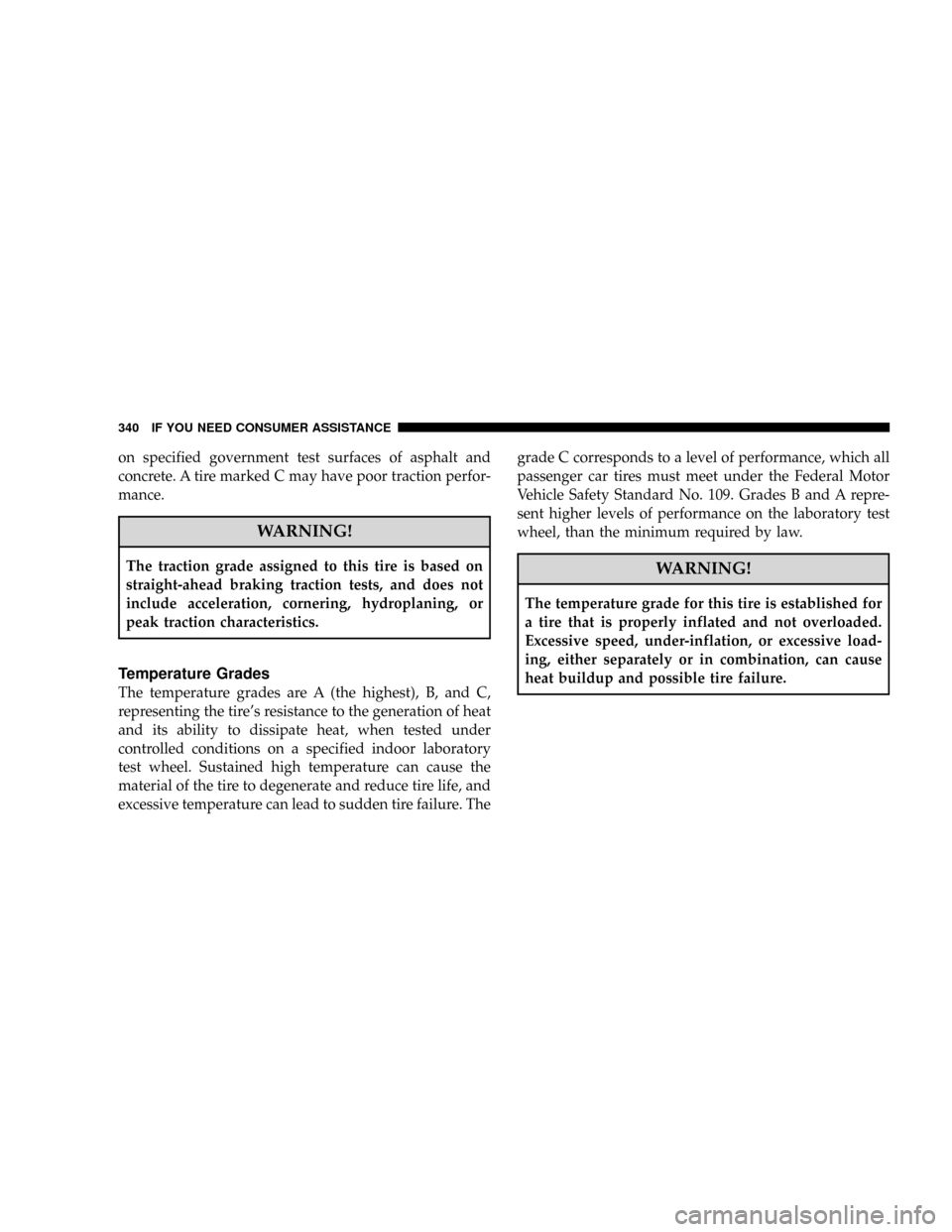
on specified government test surfaces of asphalt and
concrete. A tire marked C may have poor traction perfor-
mance.
WARNING!
The traction grade assigned to this tire is based on
straight-ahead braking traction tests, and does not
include acceleration, cornering, hydroplaning, or
peak traction characteristics.
Temperature Grades
The temperature grades are A (the highest), B, and C,
representing the tire's resistance to the generation of heat
and its ability to dissipate heat, when tested under
controlled conditions on a specified indoor laboratory
test wheel. Sustained high temperature can cause the
material of the tire to degenerate and reduce tire life, and
excessive temperature can lead to sudden tire failure. Thegrade C corresponds to a level of performance, which all
passenger car tires must meet under the Federal Motor
Vehicle Safety Standard No. 109. Grades B and A repre-
sent higher levels of performance on the laboratory test
wheel, than the minimum required by law.
WARNING!
The temperature grade for this tire is established for
a tire that is properly inflated and not overloaded.
Excessive speed, under-inflation, or excessive load-
ing, either separately or in combination, can cause
heat buildup and possible tire failure.
340 IF YOU NEED CONSUMER ASSISTANCE
Page 354 of 358
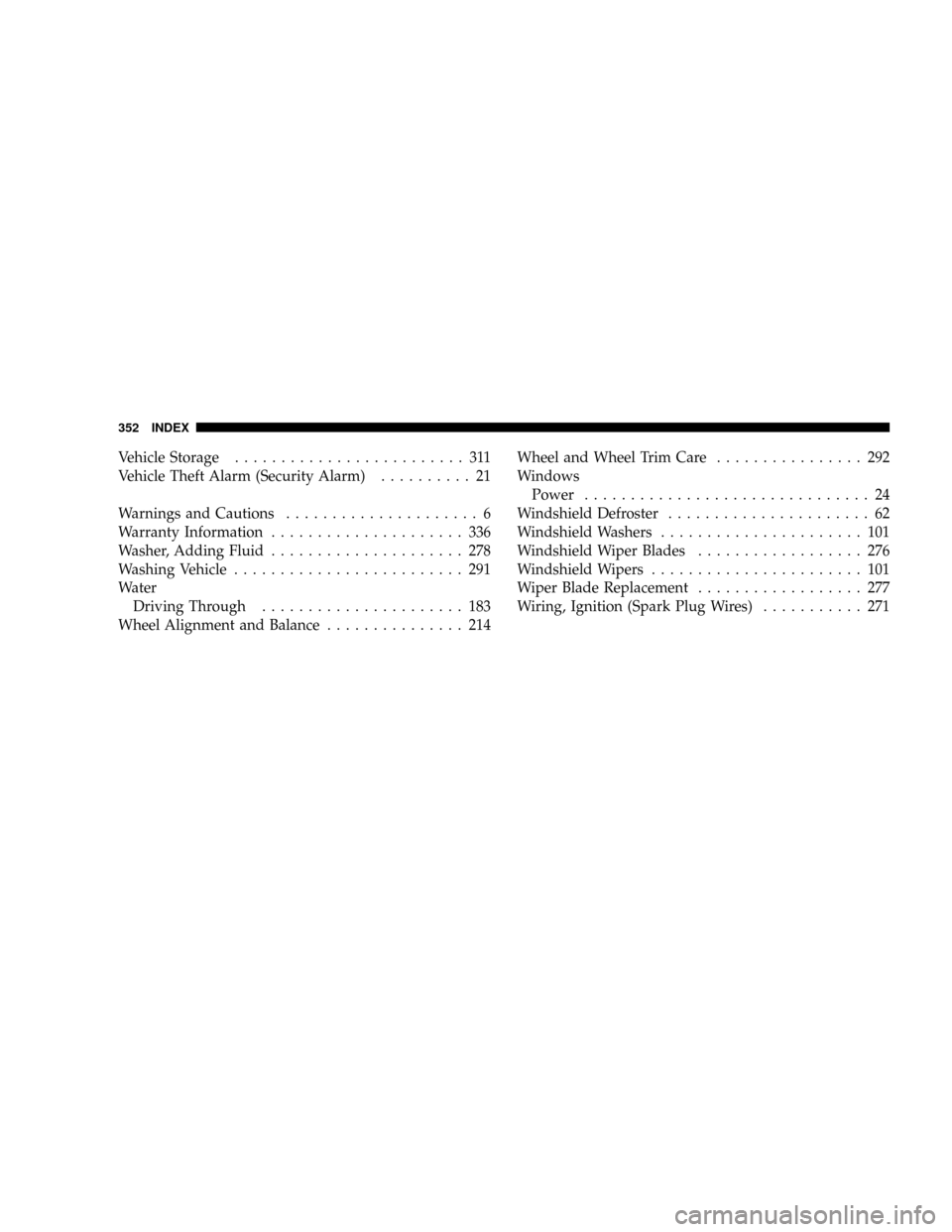
Vehicle Storage......................... 311
Vehicle Theft Alarm (Security Alarm).......... 21
Warnings and Cautions..................... 6
Warranty Information..................... 336
Washer, Adding Fluid..................... 278
Washing Vehicle......................... 291
Water
Driving Through...................... 183
Wheel Alignment and Balance............... 214Wheel and Wheel Trim Care................ 292
Windows
Power............................... 24
Windshield Defroster...................... 62
Windshield Washers...................... 101
Windshield Wiper Blades.................. 276
Windshield Wipers....................... 101
Wiper Blade Replacement.................. 277
Wiring, Ignition (Spark Plug Wires)........... 271
352 INDEX